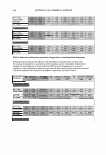HS-SPME-GC DETERMINATION OF FORMALDEHYDE 349 FID1 A, (052803B1001B0101.D) p A - 40- � · 35- J: J: Sample ID: Make-up Foundation 30- a. a. ., � � � LU 25- lei � c;i LU J: (..) a. LL 20- � lS J: OI (..) J: cxi 15- OI I N 10- - ,I 5- 0 ? I Fl 1 � {? {,1 1fl mi, Figure 3. Typical chromatogram obtained after HS-SPME of the cosmetic sample. CONCLUSION Our work has demonstrated that SPME is fast, precise, and highly sensitive, and is an alternative procedure for the determination of formaldehyde in cosmetic products such as surfactant systems, foundations, and nail-polish products. ACKNOWLEDGMENTS The authors gratefully acknowledge the technical assistance and support provided by Coty Research and Development Center and especially by Ralph Macchio. REFERENCES (1) Identification and determination of free formaldehyde, Off J. Eur. Commun., L 185/18 Oune 6, 1982). (2) C. H. Wilson, Fluorometric determination of formaldehyde in cosmetic products,]. Soc. Cosmet. Chern., 25, 67-71 (1974). (3) E. Sawicki, T. R. Hauser, and S. McPherson, Spectrophotometric determination of formaldehyde and formaldehyde-releasing compounds with chromotropic acid, 6-amino-l-naphthol-3-sulfonic acid 0-acid), and 6-anilino-l-naphthol-3-sulfonic acid (phenyl J-acid), Anal. Chem., 34, 1460 (1962). (4) P. W. West and B. Sen. Spectrophotometric determination of traces of formaldehyde,]. Anal. Chern., 153, 12-18 (1956). (5) J. Zhang, D. Thickett, and L. Green, Two tests for the detection of volatile organic acids and formaldehyde, J. Arn. Inst. Conservat., 33, 47-53 (1994). (6) Y. Hoshika, Y. Takata, Gas chromatographic separation of carbonyl compounds as their 2,4-dinitro phenylhydrazines using glass capillary columns,]. Chrornatogr., 120, 379-389 (1976). (7) P. W. Wu, C. C. Chag, and S.S. Chou, Determination of formaldehyde in cosmetics by HPLC method and acetylacetone method, J. Food Drug Anal., 11, 8-15 (2003). (8) M. I. Feldman, Determination of free formaldehyde in the presence of its compounds with amino acids and proteins, Biochemistry, 23, 867-872 (1958). (9) R. P. Belardi and J. Pawliszyn, The application of chemically modified fused silica fibers in the extraction of organics from water matrix samples and their rapid transfer to capillary columns, Water Poll. Res. J. Canada, 24, 179-189 (1989).
350 JOURNAL OF COSMETIC SCIENCE (10) C. L. Arthur and J. Pawliszyn, Solid-phase microextraction with thermal desorption using fused silica optical fibers, Anal. Chem., 62, 2145-2148 (1990). (11) B. Schafer, P. Hennig, and W. Engewald, Methodological aspects of headspace SPME: Application of the retention index system,]. High Resol. Chromatogr., 20, 217-221 (1997). (12) K. Wada and T. Shibamoto, Isolation and identification of volatile compounds from a wine using solid phase extraction, gas chromatography, and gas chromatography/mass spectrometry, J. Agric. Food Chern., 45, 4363-4366 (1997). (13) D. D. C. Garcia, M. Reichenbacher, K. Danzer, C. Hurlbeck, C Bartzsch, and K. Feller, Analysis of bouquet components using headspace-solid-phase microextraction-capillary gas chromatography, J. High Resol. Chrornatogr., 21, 373-377 (1998). (14) E. Ralf and K. Levsen, Determination of pesticides in aqueous samples by solid-phase microextraction in-line coupled to gas chromatography-mass spectrometry,]. Arn. Soc. Mass Spectrum, 6, 1119-1130 (1995). (15) D. Garcia, S. Magnaghi, and M. Reichenbacher, Systematic optimization of the analysis of wine bouquet components by solid-phase microextraction,J. High Resol. Chrornatogr., 19, 257-262 (1996). (16) Z. Zhang, M. J. Yang, and J. Pawliszyn, Solid-phase microextraction, Anal. Chern., 66, 844A-853A (1994). (17) C. L. Arthur, D. W. Potter, K. D. Buchholz, S. Motlagh, and J. Pawliszyn, Solid-phase microextrac tion for the direct analysis of water: Theory and practice, J. Liq. Chrornatogr. Gas Chrornatogr., 10, 656-661 (1992). (18) M. J. Yang, M. L. Orton and J. Pawliszyn, Quantitative determination of caffeine in beverages using a combined SPME-GC/MS method,]. Chern. Ed., 74, 1130-1132 (1997). (19) R. T. Rivero and V. Topiwala, Quantitative determination of formaldehyde in cosmetics using a combined solid-phase microextraction-isotope dilution mass spectroscopy method, J. Chrornatogr. A 1029, 217-222 (2004). (20) Y. Hoshika and G. Muto, Sensitive gas chromatographic determination of lower aliphatic carbonyl compounds as their pentafluorophenylhydrazones,J. Chrornatogr., 152, 224-227 (1978). (21) E. E. Stashenko, M. A. Puertas, W. Salgar, W. Delgado and J. R. Martinez, Solid-phase microextrac tion with on-fiber derevitation applied to the analysis of volatile carbonyl compounds,]. Chrornatogr. A, 886, 175-182 (2000).
Purchased for the exclusive use of nofirst nolast (unknown) From: SCC Media Library & Resource Center (library.scconline.org)






































































































